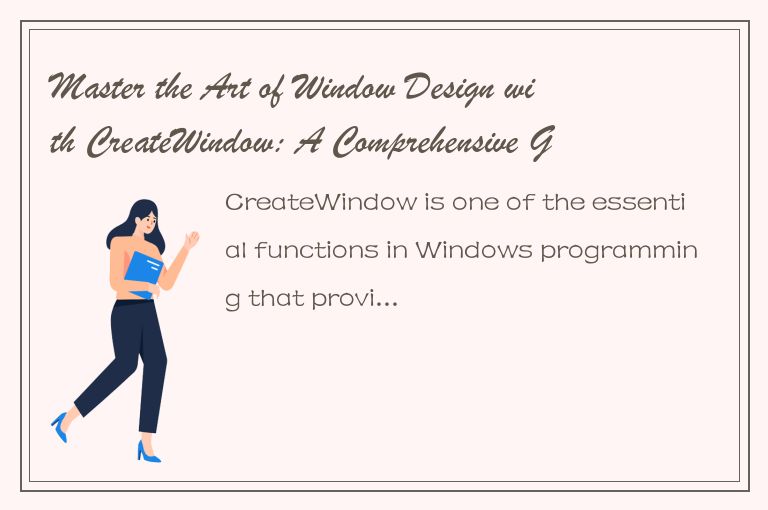CreateWindow is one of the essential functions in Windows programming that provides developers with the ability to create a window for their program. This function is widely used in desktop application development, which means that it’s crucial for developers to master the art of window designing with CreateWindow.

In this article, we’ll delve into the details of CreateWindow, its parameters, and the techniques to create a fully functional and visually appealing window.
Understanding CreateWindow Parameters
Before beginning to use CreateWindow, it is crucial to understand its parameters. There are ten parameters in total, each of which plays a crucial role in the window’s design:
1. lpClassName: This parameter is a string that represents the window’s class name. It’s used to register the window’s class and allow the system to identify it.
2. lpWindowName: This parameter is a string that specifies the window’s title bar text.
3. dwStyle: This parameter is a DWORD that represents the window’s style. The style is a combination of several flags that specify the window’s attributes and behavior, such as its border and the system menu.
4. x, y: These parameters determine the window’s initial position, relative to the screen or the parent window.
5. nWidth, nHeight: These parameters determine the window’s size.
6. hWndParent: This parameter is a handle to the parent window.
7. hMenu: This parameter is a handle to the menu, which is typically used by menu-based applications.
8. hInstance: This parameter is a handle to the instance of the application.
9. lpParam: This parameter is a pointer to a memory location containing the additional data to pass to the window’s procedure.
10. Returns: The function returns a handle to the newly created window.
Creating a Window with CreateWindow
Now that we have understood the parameters of CreateWindow let's take a look at how to use it to create a window. In this example, we will create a window and display it to the user.
#include
int WINAPI wWinMain(HINSTANCE hInstance, HINSTANCE, PWSTR pCmdLine, int nCmdShow)
{
const wchar_t CLASS_NAME[] = L"My Window Class";
WNDCLASS wc = { };
wc.lpfnWndProc = WindowProc;
wc.hInstance = hInstance;
wc.lpszClassName = CLASS_NAME;
RegisterClass(&wc);
HWND hWnd = CreateWindowEx(
0,
CLASS_NAME,
L"Learn to Program Windows",
WS_OVERLAPPEDWINDOW,
CW_USEDEFAULT, CW_USEDEFAULT, CW_USEDEFAULT, CW_USEDEFAULT,
NULL,
NULL,
hInstance,
NULL
);
if (hWnd == NULL)
{
return 0;
}
ShowWindow(hWnd, nCmdShow);
MSG msg = { };
while (GetMessage(&msg, NULL, 0, 0))
{
TranslateMessage(&msg);
DispatchMessage(&msg);
}
return 0;
}
In the above code snippet, we register our window class, which contains the window procedure, and then create our window using CreateWindowEx. The function returns a handle to our window that we can then use to manipulate it.
While this example is simplistic, it provides the foundation for creating more complex and visually appealing windows.
Customizing the Window Look and Feel
CreateWindow offers flexibility in customizing the window's look and feel. Here are some of the commonly used parameters of the dwStyle parameter:
1. WS_BORDER: Creates a thin line border around the window.
2. WS_CAPTION: Creates a title bar on the window that includes the window name.
3. WS_SYSMENU: Adds a system menu to the window, which includes standard window commands.
4. WS_MINIMIZEBOX: Adds a minimize box to the window.
5. WS_MAXIMIZEBOX: Adds a maximize box to the window.
These are just a few examples of the style parameters used to customize a window's look and feel. Developers can combine multiple parameters to design a fully functional window that meets their application's requirements.
Responding to User Interaction
After creating our window, we need to specify how to respond to user interaction events such as button clicks, mouse events, or keyboard input. This is done by creating a window procedure.
A window procedure is a callback function that responds to window events such as messages, notifications, or input. Every window created with CreateWindow has a corresponding window procedure specified in the lpfnWndProc parameter.
Let's take a look at how to create a window procedure:
LRESULT CALLBACK WindowProc(HWND hwnd, UINT uMsg, WPARAM wParam, LPARAM lParam)
{
switch (uMsg)
{
case WM_DESTROY:
PostQuitMessage(0);
return 0;
case WM_PAINT:
{
PAINTSTRUCT ps;
HDC hdc = BeginPaint(hwnd, &ps);
FillRect(hdc, &ps.rcPaint, (HBRUSH) (COLOR_WINDOW+1));
EndPaint(hwnd, &ps);
}
return 0;
default:
return DefWindowProc(hwnd, uMsg, wParam, lParam);
}
}
In the above code snippet, we define our window procedure that responds to the WM_DESTROY and WM_PAINT messages. The WM_DESTROY message is sent when the window is closed, while the WM_PAINT message is sent whenever the window is redrawn.
In response to the WM_DESTROY message, we call PostQuitMessage to terminate the message loop and exit the application. In response to the WM_PAINT message, we draw a rectangle on the window's client area using the FillRect function.
Conclusion
In conclusion, CreateWindow is an essential function in Windows programming and mastering the art of window design with CreateWindow is crucial for developers who wish to create highly functional and visually appealing desktop applications.
By understanding the parameters of CreateWindow, customizing the window look and feel, and responding to user interaction events, we can create powerful and intuitive desktop applications. With a solid foundation in Windows programming, developers can create numerous applications that meet the specific requirements of their users.




 QQ客服专员
QQ客服专员 电话客服专员
电话客服专员